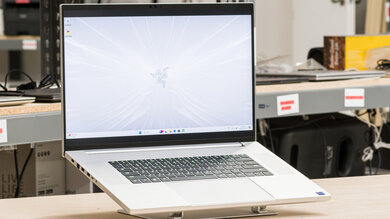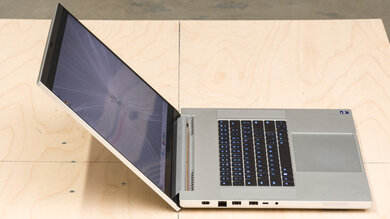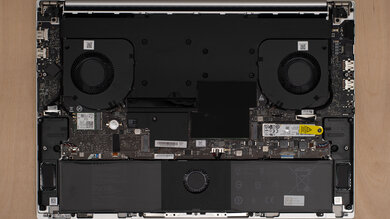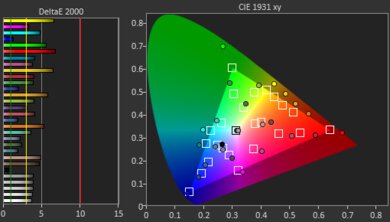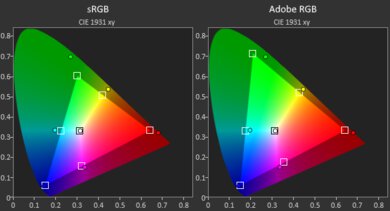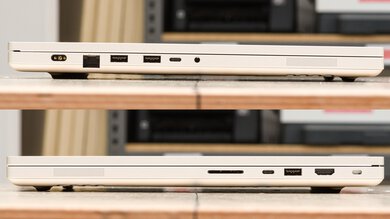The Razer Blade 18 (2024) is an 18-inch premium gaming laptop. It replaces the Blade 18 from 2023 (Intel 13th Gen). This 2024 model has an Intel Core i9-14900HX CPU paired with an NVIDIA GeForce RTX 4070, 4080, or 4090 Laptop GPU. RAM and storage max out at 64GB and 4TB, respectively. Display options include a 300Hz QHD+ (2560 x 1600) Mini LED and a 200Hz 4k+ (3840 x 2400) IPS panel; both support G-SYNC variable refresh rate. It has per-key RGB keyboard backlighting, a 1440p webcam with a privacy cover, an IR facial recognition camera, and Wi-Fi 7 wireless connectivity. Ports comprise three USB-As, two USB-Cs (one with Thunderbolt 4/5 support, depending on configuration), an HDMI 2.1, an SD card reader, and a 2.5Gbps Ethernet port.
See our unit's specifications and the available configuration options in the Differences Between Variants section.
Note: Due to the Razer Blade 18's severe performance throttling in the default Balanced mode, we've performed the productivity benchmarks, gaming benchmarks, thermals and noise, and performance over time tests using the Turbo mode with the Max Fan setting on. This methodology change makes the results more representative of the laptop's maximum potential and brings them closer to user expectations. However, this also means that the results aren't directly comparable with previous laptop reviews in which these tests were conducted in the default Balanced mode. You can see more details in the Geekbench 5 section.
Our Verdict
The Razer Blade 18 is decent for school use. It provides a good user experience with its large, bright display, tactile keyboard, and responsive touchpad. It also has plenty of processing power, making it suitable for students in fields like programming and 3D graphics. However, its large size makes it hard to carry around, and its short battery life means you'll also have to bring its bulky charger. Also, the fans get extremely loud under load, which isn't ideal for quiet classrooms and libraries.
-
Large, sharp, bright display.
-
Tactile keyboard, large and responsive touchpad.
-
CPU and GPU can handle demanding workloads.
-
Wide port selection.
-
Bulky and heavy.
-
Short battery life.
-
Performance drops significantly in 'Balanced' mode.
-
Loud fans.
The Razer Blade 18 is an outstanding gaming laptop. It has a fast Intel Core i9-14900HX CPU, which you can pair with an NVIDIA GeForce RTX 4070, 4080, or 4090 Laptop GPU, giving you plenty of processing power to deliver smooth gameplay in demanding AAA games. You can choose between a 300Hz QHD+ Mini LED or a 200Hz 4k+ display; both provide incredible responsiveness and smooth motion with almost no ghosting in fast-paced titles. They also support G-SYNC variable refresh rate to reduce screen tearing. There are plenty of ports, including a 2.5Gbps Ethernet port, to ensure a reliable internet connection when gaming online. Thermal throttling is minimal, but unfortunately, the fans are extremely loud at full speed.
-
CPU and GPU can handle demanding workloads.
-
High-refresh displays with fast response times and VRR support.
-
Wide port selection.
-
User-replaceable RAM and storage.
-
Wi-Fi 7 and 2.5Gbps Ethernet port.
-
Performance drops significantly in 'Balanced' mode.
-
Loud fans.
The Razer Blade 18 is decent for media consumption. This 18-inch model is available with a QHD+ Mini LED or 4k+ IPS display; both look bright and colorful. While not as sharp as the 4k+ panel, the QHD+ panel is better suited for dark room viewing, as it can produce much deeper blacks. Depending on your taste, you might want to calibrate the display, as the factory calibration oversaturates some colors to give a more vibrant, albeit less accurate, look. The speakers get very loud with minimal compression artifacts, and they sound clear and full, with a decent amount of bass. Unfortunately, this laptop is quite large, making it hard to carry around, and its battery life is very short at four hours of video playback.
-
Sharp, bright display with full DCI P3 coverage.
-
Mini LED display option for dark room viewing.
-
Loud speakers sound clear and full, with a decent amount of bass.
-
Bulky and heavy.
-
Short battery life.
-
sRGB content looks oversaturated.
The Razer Blade 18 isn't designed specifically for use as a workstation. It's a great option for content creators, as it has more than enough processing power to handle tasks like photo and video editing, and it's available with 100% DCI P3 displays. However, there are no professional GPU options which are better optimized for tasks like 3D modeling and simulations. The system can support up to 96GB of RAM, but you'll have to upgrade it yourself, as Razer only offers up to 64GB. Its outstanding port selection includes Thunderbolt 5 and HDMI 2.1 support, so you can easily connect multiple displays and transfer files quickly. Thermal throttling is minimal; however, the fans get extremely loud at full speed.
-
CPU and GPU can handle demanding workloads.
-
Displays are suitable for color-critical work.
-
Wide port selection.
-
Thunderbolt 5 and HDMI 2.1.
-
User-replaceable RAM and storage.
-
No professional GPU options.
-
Performance drops significantly in 'Balanced' mode.
-
Loud fans.
The Razer Blade 18 is great for business use. This premium model feels incredibly well built and provides a great user experience with its large display, tactile keyboard, and responsive touchpad. It has plenty of processing power to tackle general productivity tasks like web browsing, text formatting, and spreadsheets, as well as more demanding workloads like photo and video editing, making it a great option for those needing to make videos and ads for their own businesses. It has an excellent 1440p webcam for video calls and a wide port selection to connect multiple peripherals and external displays. Unfortunately, it's hard to carry around since this is more of a desktop replacement than a portable device for on-the-go use, and its battery life is very short at around five hours of light use.
-
Large, sharp, bright display.
-
Tactile keyboard, large and responsive touchpad.
-
Wide port selection.
-
Excellent 1440p webcam.
-
Bulky and heavy.
-
Short battery life.
- 6.9 School
- 8.9 Gaming
- 7.1 Multimedia
- 9.2 Workstation
- 8.3 Business
Changelog
- Updated May 07, 2025: We've updated this review to Test Bench 0.8.3, which removes the viewing angle tests and adds a GPU Total Graphics Power comparison in the GPU section. The Pen Input test in the Extra Features section has also changed, as it now shows whether the laptop supports pen input rather than the inclusion of a stylus in the box. See the changelog for more details.
- Updated Oct 18, 2024: Review published.
- Updated Oct 15, 2024: Early access published.
- Updated Sep 24, 2024: Our testers have started testing this product.
- Updated Sep 23, 2024: The product has arrived in our lab, and our testers will start evaluating it soon.
Differences Between Sizes And Variants
We tested the Razer Blade 18 (model RZ09-0509) with a 200Hz 4k+ IPS display, an Intel Core i9-14900HX CPU, an NVIDIA GeForce RTX 4090 Laptop GPU, 32GB of RAM, and 2TB of storage. The display, GPU, memory, and storage are configurable; see below for all the configuration options.
SCREEN
- 18" Mini LED 2560 x 1600 300Hz (matte, 100% DCI P3, G-SYNC)
- 18" IPS 3840 x 2400 200Hz (matte, 100% DCI P3, G-SYNC)
CPU
- Intel Core i9-14900HX (24 cores/32 threads, up to 5.5GHz, 24MB cache)
GPU
- NVIDIA GeForce RTX 4070 Laptop GPU 8GB GDDR6 (140W TGP /w Dynamic Boost)
- NVIDIA GeForce RTX 4080 Laptop GPU 12GB GDDR6 (175W TGP /w Dynamic Boost)
- NVIDIA GeForce RTX 4090 Laptop GPU 16GB GDDR6 (175W TGP /w Dynamic Boost)
MEMORY
- 32GB DDR5 5600MHz
- 64GB DDR5 5600MHz
STORAGE
- 1TB M.2 PCIe Gen 4 NVMe SSD
- 2TB M.2 PCIe Gen 4 NVMe SSD
- 4TB M.2 PCIe Gen 4 NVMe SSD
COLOR
- Mercury White
- Black
See our unit's label.
Compared To Other Laptops
The Razer Blade 18 is an excellent gaming laptop. It has plenty of processing power to deliver smooth gameplay in demanding AAA games and is available with fast, VRR-enabled displays. Its build quality is outstanding and among the best you can find on the market, and it provides a superior user experience than most laptops, including productivity models. That said, you can get similar performance on significantly cheaper laptops. Also, its sheer size and short battery life make it more of a desktop replacement rather than a portable model for on-the-go use.
For more options, check out our recommendations for the best gaming laptops, the best budget and cheap gaming laptops, and the best laptops for video editing.
The Razer Blade 18 (2024) and the Dell Alienware m18 R2 (2024) are both 18-inch gaming laptops configurable with Intel 14th Gen HX CPUs and NVIDIA 40-series GPUs. Generally speaking, the Blade 18 has a more premium feel and better features, like a higher-resolution 4k+ and a Mini LED display option, a larger touchpad, Thunderbolt 5 support, better-sounding speakers, and a higher-quality webcam. However, the Alienware m18 has more configuration options, making it easier to get a model that fits your budget, and its top-end models have more storage slots. Performance is pretty similar between these two laptops, though the Alienware gets much hotter under load.
The Razer Blade 18 (2024) and the ASUS ROG Zephyrus G16 (2024) GU605 are both high-end gaming laptops that provide a great user experience. The Blade 18 is more of a desktop replacement due to its large size, while the Zephyrus G16 is more compact and better suited for on-the-go use. Performance-wise, you can get more processing power on the Blade 18, as it has a faster Intel 14th Gen HX CPU, and its NVIDIA GPUs run at higher wattages. Also, it doesn't suffer from the performance inconsistencies encountered on the G16. On the other hand, the G16 has more configuration options, so it's easier to find a model that fits your budget. If RAM upgradeability is important to you, know that only the Blade 18's memory is user-replaceable.
Though both are gaming laptops, the Razer Blade 18 (2024) and the ASUS ROG Zephyrus G14 (2024) are quite different, as the Blade 18 is a large 18-inch model designed to be a desktop replacement, while the G14 is a much more portable model for on-the-go use. The Blade 18 will give you more processing power, as it's available with a faster Intel 14th Gen HX CPU and higher-end NVIDIA GPUs, including an RTX 4080 and 4090 Laptop GPU. It also has higher-refresh display options, a better webcam, a wider port selection, and user-replaceable RAM. On the other hand, the G14's battery life is much better in light uses, making it a better option as a general productivity device.
The Razer Blade 18 (2024) is better than the Dell Alienware m16 R2 (2024) for most uses. The Blade 18 has a more premium build and provides a better user experience overall. It's also available with a faster Intel 14th Gen HX CPU and NVIDIA GPUs, giving you more processing power for a smoother gaming experience. The Alienware is more portable, though, making it a better option for on-the-go use.
The HP OMEN MAX 16 (2025) and the Razer Blade 18 (2024) are both high-end gaming laptops. The Blade 18 feels more premium and generally provides a better user experience overall. It's a larger device intended more as a desktop replacement, though the OMEN MAX 16 isn't really well suited for on-the-go use either, as it's rather bulky and heavy. Performance-wise, while the OMEN MAX 16 comes out slightly ahead, it isn't by much, as its NVIDIA 50-series GPUs are only a minor upgrade over the Blade 18's 40-series GPUs.
Test Results
The Razer Blade 18 2024 is available in a Mercury White or Black colorway. See the bottom of the laptop.
The Razer Blade 18's build quality is outstanding. The whole device feels well-assembled, with no obvious gaps in the construction. Its full-aluminum chassis feels sturdy; there's only a little bit of flex on the lid, but only if you apply intentional force. The keyboard deck is rock solid, and the display doesn't twist when manipulating it. The finish is fairly scratch-resistant; fingerprints and smudges aren't a problem on the Mercury White model, though it's likely worse on the Black model. The feet feel sturdy and stick firmly to the bottom.
Serviceability is good. To access the internals, you only need to remove 10 T5 screws and pull off the bottom panel. While a prying tool isn't necessary, it does take some effort to remove the panel. All the screws are of the same size, so you don't have to worry about keeping them organized. You can upgrade the memory up to a maximum of 96GB. Both storage slots support M.2 2280 PCIe Gen 4 NVMe SSDs.
Razer doesn't provide a service manual.
The Razer Blade 18 is available with the following displays:
- 18" Mini LED 2560 x 1600 300Hz (matte, 100% DCI P3)
- 18" IPS 3840 x 2400 200Hz (matte, 100% DCI P3)
The 4k+ display looks very sharp, with a pixel density in the same ballpark as the Apple MacBook Pro 16 (M3, 2023)'s Mini LED screen. The QHD+ isn't as sharp (168 PPI), though the difference might not be immediately noticeable when playing fast-moving games in which you don't have the time to appreciate the graphics. Both panels have a 16:10 aspect ratio, which doesn't affect gaming much but is great for productivity, as it gives you more vertical space than a standard 16:9 screen, allowing you to see more information when reading a document without having to scroll. The downside is that you'll almost always have black bars at the top and bottom when watching standard 16:9 videos.
The 200Hz 4k+ display has a fast response time, resulting in a clear image with minimal ghosting in fast-moving scenes. The 300Hz QHD+ display will give you even smoother motion and better responsiveness. Both displays support G-SYNC to reduce screen tearing.
When running on battery, the system limits the refresh rate to 120Hz in light workloads that only engage the integrated GPU. You must force the system to use the dedicated GPU if you want the display to run at 200Hz.
The 4k+ IPS panel has an okay contrast ratio that's within the typical range of most IPS panels. However, it's still pretty low compared to other display technologies like VA and OLED. This contrast level makes blacks look gray in dim settings. The QHD+ Mini LED display has a much higher contrast ratio since it has local dimming. This means it can produce deep blacks, but there might be some blooming around bright objects in dark scenes, similar to the Apple MacBook Pro 16 (M3, 2023)'s display.
The 4k+ IPS panel gets bright enough for use in most indoor environments. Outdoor use is possible during the day, but you may have trouble seeing dark-color content. It gets very dim at the lowest brightness setting, which helps reduce eye strain when viewing content in the dark. Razer doesn't advertise the QHD+ Mini LED display's brightness.
The screen technically has a matte finish, but it looks and behaves like a cross between a glossy and matte display. It's better at handling direct, mirror-like reflections than a true glossy finish, but it doesn't suffer as much from the halo-like effects around bright objects often seen on matte finishes. For the most part, you'll only have trouble seeing dark color content if there's bright light shining directly on the screen. The QHD+ Mini LED display has the same anti-reflective coating.
The 200Hz 4k+ display's accuracy is okay out of the box. The panel uses the DCI P3 color space when there isn't a set color profile, resulting in some oversaturation. Some people may prefer this oversaturated look; just know that it isn't accurate. The white balance inaccuracies are relatively minor, and the color temperature is only slightly cooler than the standard 6500K target, which isn't enough to make a huge difference visually. The gamma follows the curve fairly well; most scenes are a tad too dark, while bright scenes are slightly too bright.
Razer Synapse has several preset color profiles, including DCI P3, Adobe RGB, Rec. 709, and sRGB. However, selecting a color profile doesn't seem to have any effect. This may be a software bug; let us know in the discussions if you've experienced the same issue.
The Razer Blade 18's 4k+ IPS display has an outstanding color gamut. It has full coverage of the sRGB and DCI P3 color spaces, making it suitable for viewing and producing SDR and HDR content. Its Adobe RGB coverage is excellent but likely not enough for professional print photography and art prints, as it can't reproduce the highly saturated greens that define Adobe RGB. The QHD+ Mini LED display has the same advertised color gamut.
The Razer Blade 18 2024 has an outstanding keyboard. The keys have a good amount of travel, require little force to actuate, and provide clear, satisfying tactile feedback. However, keycap stability is a tad inconsistent, as some keys feel more wobbly than others. While there isn't anything weird about the layout, the keyboard's large size can take some time to get used to, and it may cause fatigue over time, too, as you'd have to move your hands more to reach certain keys if you have small hands. You can customize the per-key RGB backlighting via the Razer Synapse application. The backlight's uniformity is good but not great, as it looks dimmer on some keys, particularly the bottom row.
The Razer Blade 18 2024 has an excellent touchpad. It's large and responsive to all movements and gestures. There are no issues when performing actions like dragging and dropping or zooming in and out of images. However, palm detection doesn't always work, resulting in occasional triggers when typing. This is a diving board touchpad with mechanical buttons, so you can't click in the top quarter portion of the touchpad. The buttons work well but feel a bit mushy.
The speakers get very loud with minimal compression artifacts at high volume levels. They sound clear, relatively natural, and full, with a decent amount of bass. However, the treble sounds a tad tinny, and there isn't much soundstage.
The Razer Blade 18's webcam is outstanding. The image looks clear and detailed, with only a little bit of noise. However, the exposure is too low, and the color temperature is a tad too warm. Voices come across loud and clear over the microphone, with little to no background noise. The privacy cover is a physical barrier that also disables the camera and microphone at the software level.
The Razer Blade 18 has an outstanding port selection. All three USB-As support USB 3.2 Gen 2 data transfer speed of up to 10Gbps. The two USB-Cs are slightly different; the right one supports Thunderbolt 5 (Thunderbolt 4 on models with an RTX 4070), while the left one supports USB 3.2 Gen 2. Both USB-Cs support DisplayPort 1.4 and have a direct connection to the dGPU. They also support Power Delivery for fast charging; however, they can only take up to 100W of power, meaning the battery will discharge if you perform intensive tasks while charging. The Ethernet port has a maximum speed of 2.5Gbps.
The Razer Blade 18's wireless adapter is an Intel Wi-Fi 7 BE200 320Hz. Like Wi-Fi 6E, Wi-Fi 7 gives you access to the 6GHz band but with even faster speeds and lower latency. However, to benefit from these features, you need a router that supports Wi-Fi 7. If you want to upgrade your router, check out our recommendations for the best Wi-Fi routers.
The Razer Blade 18 2024 is only available with an Intel Core i9-14900HX, a high-performance processor typically found in gaming and workstation laptops. This 24-core CPU (eight performance and sixteen efficiency cores), a refresh of Intel's Raptor Lake chips, is among the fastest of its generation. It can handle general productivity tasks like web browsing and video playback, as well as highly intensive tasks like gaming, simulations, and 3D modeling. See more information about the Core i9-14900HX on Intel's product specifications page.
The Razer Blade 18 is available with the following GPUs:
- NVIDIA GeForce RTX 4070 Laptop GPU 8GB GDDR6 (140W TGP /w Dynamic Boost)
- NVIDIA GeForce RTX 4080 Laptop GPU 12GB GDDR6 (175W TGP /w Dynamic Boost)
- NVIDIA GeForce RTX 4090 Laptop GPU 16GB GDDR6 (175W TGP /w Dynamic Boost)
The available GPUs range from the upper mid-range RTX 4070 to the top-end RTX 4090 in NVIDIA's 40-series lineup. All three GPUs support the same features, so you aren't losing any features if you get a model with a 4070 or 4080. As for the intended gaming resolution, the RTX 4070 is mainly for 1440p gaming, while the RTX 4090 is mainly for 4k gaming. The RTX 4080, which sits between the RTX 4070 and 4090, can handle most titles at 4k, but you'll have to tweak the graphical settings and rely on features like DLSS and/or Frame Generation to get playable frame rates. It's worth noting that even though the RTX 4070 can deliver a relatively good gaming experience at 1440p, its 8GB of VRAM is quite limiting and may cause stutters in memory-intensive games. This will only get worse as games become more demanding in the future. All three GPUs are well-suited for content creation; however, if you plan on doing more specialized work like 3D modeling and simulations, you're better off getting a laptop with a professional GPU, like the Lenovo ThinkPad P1 Gen 7 (2024). See more details about the 40-series laptop GPUs on NVIDIA's product specifications page.
You can configure the Razer Blade 18 with 32GB or 64GB of RAM. The memory is user-upgradeable up to 96GB.
You can configure the Razer Blade 18 2024 with 1TB, 2TB, or 4TB of storage. The SSD is user-replaceable. There are two storage slots; both support M.2 2280 PCIe Gen 4 NVMe SSDs.
The Razer Blade 18's Intel Core i9-14900HX is one of the fastest CPUs of its generation, scoring remarkably well in the Geekbench 5 benchmarks. This level of performance is suitable for even the most demanding productivity tasks. However, it's important to note that, unlike other laptop reviews, the posted results here—as well as the results in the other benchmarks—are scores obtained in the Turbo mode with the fans set to max speed. We've deviated from the normal testing procedure, which is to use the default Balanced mode, because the Blade 18's Balanced mode causes significant throttling in multi-threaded workloads, reducing the score by roughly 30% to 13,954. The Balanced mode score isn't representative of the Blade 18's performance, and posting it would have made the Blade 18 seem like it's underperforming compared to other laptops with the same CPU (Dell Alienware m18 R2 (2024)), which isn't really the case, as it's merely a matter of changing the performance mode. Moving forward, we'll be conducting all benchmarks in the maximum performance mode available. This will give users a better idea of the laptop's full potential (knowing that you can always turn it down if you prioritize battery life and/or lower fan noise and thermals), whereas the Balanced mode score would only show the manufacturer's tuning of that mode, leaving users wondering what the laptop can actually do if everything were set to max.
As for the GPU, all available GPUs can handle intensive workloads, so choose based on your budget and needs. Switching to the Balanced mode reduces the score to 244,381, which is only a 2.9% performance drop.
The Razer Blade 18's Intel Core i9-14900HX scores remarkably well in Cinebench R23, making it suitable for intensive applications and heavy multitasking. Again, these are numbers obtained in the Turbo mode with the fans set to max. The Balanced mode reduces the multi-thread score by roughly 46% to 15,097.
The Razer Blade 18 is outstanding for Blender work. Every GPU configuration can handle 3D rendering, so choose based on your budget and needs. Switching to the Balanced mode roughly doubles the CPU rendering time to three minutes but has little to no effect on GPU rendering times.
The Basemark GPU score is outstanding and in the expected range for an NVIDIA GeForce RTX 4090 Laptop GPU running at 175W (/w Dynamic Boost). As mentioned in the GPU section, the RTX 4090 is mainly for 4k gaming. You'll have to tweak the graphical settings a bit to get playable frame rates in the most demanding games, though not as much as the RTX 4080. The RTX 4070 is mainly for 1440p gaming; it can handle some titles at 4k, but only with relatively low settings and performance boosting features like DLSS. Switching to the Balanced mode reduces the score to 194,760, roughly a 17% performance loss.
Note: When running on battery, the system limits the display's refresh rate to 120Hz in lighter workloads that only engage the integrated GPU but keeps it at 200Hz in demanding workloads that require the dedicated GPU. As such, we've conducted the battery life for web browsing and video playback tests with the display at 120Hz and the gaming test with the display at 200Hz.
Although the average frame rate is high in Borderlands 3, the gameplay is sometimes choppy due to frame drops, with the frame rate dropping well below 60 fps. On an RTX 4090 model, running the game at the native 4k+ resolution results in a lower average frame rate of 139 fps with high settings, but the overall gameplay feels smoother because the frame drops aren't as drastic. Configurations with an RTX 4070 and 4080 can also handle this and other similar games, but you'll have to play with the settings a bit to get the best experience.
Here are additional benchmarks in Red Dead Redemption 2 to give you a better idea of the performance:
- Avg. FPS, 1080p, high settings: 133 fps
- Avg. FPS, 4k+, high settings: 66 fps
Every configuration of the Razer Blade 18 2024 can handle Civilization VI and other similar strategy games with no issues, whether you play at 1080p, 1440p, or 4k. The average frame rate at the display's native 4k+ resolution is 160 fps with high settings and 219 fps with low settings. The average turn time is good and among the fastest you can get on current generation CPUs.
Every configuration of the Razer Blade 18 can run Counter-Strike 2 and other similar games smoothly at 1080p, 1440p, or 4k with few tweaks in the graphical settings. There are some micro stutters, but they don't happen often enough to affect the gameplay significantly. At the display's native 4k+ resolution, the average frame rate is 112 fps with high settings and 291 fps with low settings.
Shadow of the Tomb Raider runs very smoothly on the Razer Blade 18 at 1080p. You can even play this game and other similar titles at 4k on configurations with an RTX 4080 or 4090, with the latter pushing an average frame rate of 92 fps with high settings and 137 fps with low settings (no DLSS).
Except for the Fan Noise While Idle measurement, the posted results are temperatures and fan noise levels obtained using the Turbo mode with the Max Fan setting on. The Max Fan setting makes the fans run at full speed, even in an idle state. Though away from where most people rest their hands, it's worth noting that the back of the deck (where the vents are) can get as hot as 50.2 °C (122.36 °F) in the Balanced mode and 54 °C (129.2 °F) in the Turbo mode. The bottom of the laptop reaches 45.4 °C (113.72 °F) in the Balanced mode and 57.8 °C (136.04 °F) in the Turbo mode.
We've conducted this test using the laptop's best performance (Turbo) mode with the fan speed at max instead of the default Balanced mode we've used in previous laptop reviews.
The Razer Blade 18 has a few pre-installed applications, including:
- Razer Synapse: Lets you change or make a custom power/performance profile, change the fan speed, and change the display's color profile. You can also use it to customize the keyboard's RGB backlighting and other Razer peripherals. See our recommendations for the best Razer mice and best Razer keyboards.
- THX Spatial Audio: Adds support for 7.1 surround sound.
The Razer Blade 18 2024 has a facial recognition IR camera. You can use it to log in quickly, authorize purchases in the Windows Store, and auto-fill saved passwords on supported websites. The keyboard has per-key RGB backlighting; you can customize it via the Razer Synapse application.
Comments
Razer Blade 18 (2024): Main Discussion
Let us know why you want us to review the product here, or encourage others to vote for this product.
Update: We’ve updated this review to Test Bench 0.8.3, which removes the viewing angle tests and adds a GPU Total Graphics Power comparison in the GPU section. The Pen Input test in the Extra Features section has also changed, as it now shows whether the laptop supports pen input rather than the inclusion of a stylus in the box. See the changelog for more details.
- 21010
Ahh I see, imo frequency response accuracy, more importantly bass extension for laptops is more important as most laptops struggle heavily with this except Apple
I appreciate the feedback and I’ll make sure to bring it up when we revisit the scoring/update the test! Thanks for the comment and feel free to post more if you have more comments on the tests!
- 21010
Ahh I see, imo frequency response accuracy, more importantly bass extension for laptops is more important as most laptops struggle heavily with this except Apple
- 21010
I see, I assume u guys tested it in thx spatial mode for music, will it be possible to test the frequency response again but with music and just normal stereo? The spatial mode makes everything sound tinny and bass isn’t as prominent as stereo due to the boost in highs to make everything sound more spatial🤣 The blade 18 has a larger speaker enclosure and larger force cancelling woofers than the MacBook Pro 16 and imo with the correct eq it should perform similarly but with reduced peak volume which the Mac also has compared to the blade 18
Yes, that’s correct. We don’t go too much into the speakers as we can’t be sure which mode is best without more extensive testing, as we don’t want to lean too much into subjectivity with this test bench. That said, it’s totally possible that we shift this philosophy for future test benches.
Our current scoring does take value peak volume very highly (35.2%), so if switching it does reduce the peak volume and decrease the bass extension on our readings, the overall score will trend downwards from it’s current value, so it might appear worse on our current test, even though it may technically sound better. This is absolutely a flaw with our current test, so I’ll happily add it to our suggestions for next year.
- 21010
I see, I assume u guys tested it in thx spatial mode for music, will it be possible to test the frequency response again but with music and just normal stereo? The spatial mode makes everything sound tinny and bass isn’t as prominent as stereo due to the boost in highs to make everything sound more spatial🤣 The blade 18 has a larger speaker enclosure and larger force cancelling woofers than the MacBook Pro 16 and imo with the correct eq it should perform similarly but with reduced peak volume which the Mac also has compared to the blade 18
- 21010
Hi, may I know what speaker mode/eq in synapse was used for the speaker tests as well as will it be possible to test the miniled panel variant of the laptop instead as it is a far more popular and superior display choice for this laptop. Thanks!!
Hey!
We always test in the default speaker modes. In this case, it was in “Music” setting. As for the mini-LED panel variant, I’d personally love to test that one to see the differences, but I can confidently tell you that it’ll be a better buy if you’re willing to spend the money. You can definitely expect better contrast, better brightness and I’d expect it to have better out of the box color accuracy.
Any of these kinds of enthusiast gaming machines are going to be really good across the board, but you’re definitely paying a heftier price for it. There might be that option on the next Razer laptop we buy, so if you want to vote for another one so we can prioritize and get it out check out the voting poll here.
- 21010
Hi, may I know what speaker mode/eq in synapse was used for the speaker tests as well as will it be possible to test the miniled panel variant of the laptop instead as it is a far more popular and superior display choice for this laptop. Thanks!!
- 21010
Nice review! Though, why pick this laptop over an OLED panel (way better than Mini-LED or IPS panels for GAMING by a margin) laptop with the same specs? No offense.
Hi,
We reviewed the Razer Blade 18 because it was one of our poll winners. We also have to consider that not everyone likes OLED, whether it’s due to the possibility of permanent burn-in or sensitivity to OLED’s flicker. Hope that helps.


